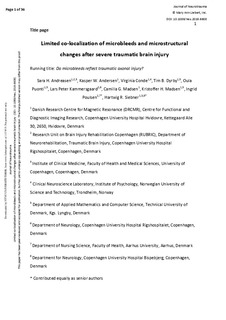| dc.description.abstract | Severe traumatic brain injury (TBI) produces shearing forces on long-range axons and brain vessels, causing axonal and vascular injury. To examine whether microbleeds and axonal injury co-localize after TBI, we performed whole-brain susceptibility-weighted imaging (SWI) and diffusion tensor imaging (DTI) in 14 patients during the subacute phase after severe TBI. SWI was used to determine the number and volumes of microbleeds in five brain regions: the fronto-temporal lobe, parieto-occipital lobe, mid-sagittal region (cingular cortex, parasagittal white matter and corpus callosum), deep nuclei (basal ganglia and thalamus), and brainstem. Averaged fractional anisotropy (FA) and mean diffusivity (MD) were measured to assess microstructural changes in the normal appearing white matter due to axonal injury in the same five regions. Regional expressions of microbleeds and microstructure was used in a partial least squares model to predict the impairment of consciousness in the subacute stage after TBI as measured with the Coma Recovery Scale-Revised (CRS-R). Only in the midsagittal region, expression of microbleeds correlated with regional changes in microstructure as revealed by DTI. Microbleeds and microstructural DTI-based metrics of deep but not superficial brain regions were able to predict individual CRS-R. Our results suggest that microbleeds are not strictly related to axonal pathology in other that the midsagittal region. While each measure alone was predictive, the combination of both metrics scaled best with individual CRS-R. Structural alterations in deep brain structures are relevant in terms of determining the severity of impaired consciousness in the acute stage after TBI. | nb_NO |
